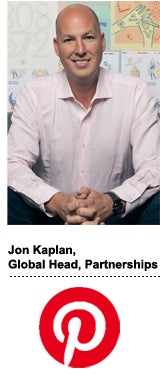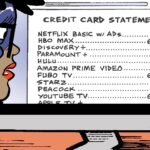There are only around 2.5 million weddings in the United States every year – yet more than 30 million people are planning a wedding on Pinterest at any given time.
“That means there’s a lot of planning being done long before a wedding ever happens,” said Jon Kaplan, who joined Pinterest in 2016 as global head of partnerships after more than 12 years in executive sales roles at Google.
At the same time, of the billions of monthly searches on Pinterest, 97% don’t have a specific brand associated, Kaplan said, which is very different from how people use other platforms like Google, where searches happen toward the bottom of the funnel.
Kaplan convinces brands that Pinterest can help them reach consumers when they have high commercial intent, but still haven’t decided what they’ll buy.
“If we’re doing this right, we should be able to introduce new customers and drive growth for our advertisers in moments when users are receptive, but still undecided,” Kaplan said.
When someone is ready to buy, Pinterest wants a piece of the action. Shopping has always been a focus at Pinterest, but 2019 will see more shopping behavior enabled on the platform. In early March, Pinterest rolled out tools to make it easier for retailers to upload their product catalogs and automatically create shopping ads.
AdExchanger chatted with Kaplan.
AdExchanger: What was the potential you saw in Pinterest after more than a decade at Google?
JON KAPLAN: It goes back to being a user myself, which started by watching my wife use it, and it’s been reinforced in talking to other users about why they come to Pinterest. People are looking for inspiration, new ideas or to plan for their future, everything from what they want to eat to the bigger things in life, like traveling, getting married or buying a house.
That sounds a lot like the intent Google sees, but it’s actually a very different user behavior that can provide advertisers with a powerful value proposition. Google and Amazon are great places when you know what you want, but we’re the starting point for someone looking for new ideas.
What are your top priorities this year?
We’re trying to diversify the types of budgets and objectives we can serve by moving further down the funnel in terms of performance. When someone is ready to buy something, we want to make that into a frictionless experience. That is the biggest piece of feedback we get from users, that when they find what they want, they want to be able to buy that thing.
We’re also looking to diversify who we serve. One way is through international expansion. We opened France in October [and Germany in early March]. In the United States, we’ve also made a concerted effort to put teams against DTC and digitally native brands. Traditionally, DTC brands started on Facebook and Instagram, but we’re starting to see success with these types of companies, and it makes sense. If you’re an unknown brand with a great product to offer, you want to reach someone when they’re in market, but still undecided, which evens the playing field for the brand.
What are the top questions you get from brands and agencies?
They want to understand how people are using Pinterest in their category, whether that’s home, beauty, fashion, food, travel or whatever it is. The starting point of every discussion is, how can we unpack what people are doing on the platform in a way that’s interesting to the advertiser. And then it’s about helping the brand become a utility to users in the moment, and figuring out what creative execution works in that context.
What about the measurement piece?
Advertisers want to know how Pinterest drives sales or the likelihood to purchase, and we have around 14 measurement partners we work with across the full range of objectives, from online sales to brand lift to foot traffic. People don’t necessarily click directly from an ad every time and convert on Pinterest, but they do save brand content to boards and often return to that content later. Our goal is to capture the total economic impact of our ads on topline sales. It’s a different way of thinking about attribution, because the behavior is different.
How does Pinterest nurture small and medium-sized businesses on the platform?
SMBs are hugely important to us, and they’re already getting a lot of organic value out of Pinterest by creating business profiles and posting content. To help them take it to the next level, we’ve been developing tools and systems to help them easily start advertising. We have a self-serve system today, but we’re trying to make it even simpler going forward so that there are as few steps as possible in the workflow.















